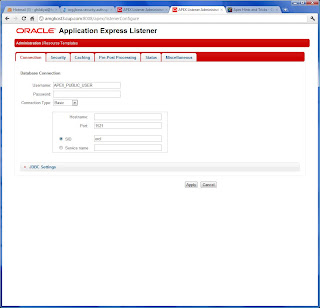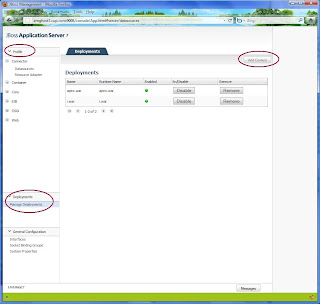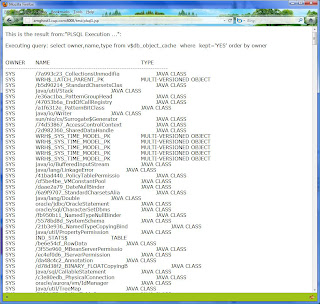APEX with JBOSS 7:
Well, I spent 3 days to get this going. It is not pretty but it works and I am sharing all the mess I had to go through to make it work.
1- Download JDK 7 from here - http://www.oracle.com/technetwork/java/javase/downloads/index.html
2- Download JBOSS 7 from here http://www.jboss.org/jbossas/downloads/
I downloaded 7.0.2 final
3- unzip JDK 7 and asign th eunzipped directorya s JAVA_HOME and add to the path. For me:
export JAVA_HOME=/home/oracle/jdk1.7.0_01
export PATH=$JAVA_HOME/bin:$PATH
4- unzip the jboss and assign this as JBOSS_HOME. for me it is:
JBOSS_HOME=/home/oracle/jboss702
(Please do not start the jboss yet)
5- Please copy the images for APEX as defined in step 4 here - http://apexdplsepg.blogspot.com/2011/12/install-upgrade.html
6- Untar the images from step5 to $JBOSS_HOME/standalone/deployments. for me it is:
/home/oracle/jboss702/standalone/deployments
7- Download the APEX listener and extract the apex.war from here -
http://www.oracle.com/technetwork/developer-tools/apex-listener/downloads/index.html
8- Please do this as indicated below - Very important steps below.
cd $JBOSS_HOME/standalone/deployments
mkdir apex.war
cd apex.war
jar -xvf /homne/oracle/dwnld/apex/apex.war
(Please note that I downloaded and unzipped the APEX listener at /home/oracle/dwnld/apex location)
mkdir /home/oracle/aptmp
cd /home/oracle/aptmp
jar -xvf $JBOSS_HOME/standalone/deployments/apex.war/WEB-INF/lib/apex.jar
cd META-INF
vi oracle.dbtools.rt.services
delete the following line from it:
oracle.dbtools.rt.uri.WarURIResolver
save and exit
now repackage this as:
cd ../ to go to /home/oracle/aptmp
jar -cvf /home/oracle/apex.jar *
(This will create apex.jar in the /home/oracle direvctory)
rm -f $JBOSS_HOME/standalone/deployments/apex.war/WEB-INF/lib/apex.jar
cp apex.jar $JBOSS_HOME/standalone/deployments/apex.war/WEB-INF/lib/
cd $JBOSS_HOME/standalone/deployments/apex.war/WEB-INF
vi adminTemplate.html
Replace all scripts to /i/scripts. This is because for some reason when JBOSS deploys the apex.war there is no directory access inside the apex.war and I did not want to put a lot of time to find out as where this permission is set. I look arounf in the web.xml and others but could not find it. However i.war is accessible for other APEX images so I decided to do this way.
Mine looks like:
amghost3:Oracle ->> grep scripts adminTemplate.html
<link rel="shortcut icon" type="image/vnd.microsoft.icon" href="/i/scripts/images/oracle.ico" />
<link rel="stylesheet" type="text/css" href="/i/scripts/css/styles.css" />
<link rel="stylesheet" type="text/css" href="/i/scripts/css/jquery-ui-1.8.5.custom.css" />
<script type="text/javascript" src="/i/scripts/js/jquery-1.4.2.min.js"></script>
<script type="text/javascript" src="/i/scripts/js/jquery-ui-1.8.5.custom.min.js"></script>
<img src="/i/scripts/images/oracle_logo.gif" width="133" height="18"alt="Oracle" class="banner" />
cd ../ (One step up to /home/oracle/jboss702/standalone/deployments/apex.war)
cp -R scripts ../i.war/
now cd $JBOSS_HOME/bin
edit the jboss-admin.sh and change the last line as:
eval \"$JAVA\" $JAVA_OPTS -jar \"$JBOSS_HOME/jboss-modules.jar\" -logmodule "org.jboss.logmanager" -
mp \"$JBOSS_HOME/modules\" org.jboss.as.cli '--connect controller=amghost3.cup.com:9009 "$@"'
(Please note that I decided to run the web server on 8008 port and 9009 and 9008 for Admin. console)
vi standalone.conf
change the JAVA_OPTS. Mine is:
if [ "x$JAVA_OPTS" = "x" ]; then
JAVA_OPTS="-Xms64m -Xmx512m -XX:MaxPermSize=256m -Djava.net.preferIPv4Stack=true -Dorg.jboss.resolver.warning=true -Dsun.rmi.dgc.client.gcInterval=3600000 -Dsun.rmi.dgc.server.gcInterval=3600000"
JAVA_OPTS="$JAVA_OPTS -Djboss.modules.system.pkgs=$JBOSS_MODULES_SYSTEM_PKGS -Djava.awt.headless=true -Dapex.home=/home/oracle/apex -Dapex.images=/home/oracle/jboss702/standalone/deployments/i.war"
(Please note that the reason I pu the apex variables here is because when we do the listenerConfigure - it will create the conf file in /tmp/apex - so to make it appropriate I did this)
now cd to $JBOSS_HOME/standalone/configuration and edit teh standalone.xml file. Please note the following changes. These changes are to have HTTP/1.1 in UTF-8 format and Admin and Manager Roles and users for APEX.
Just below </extension at the top of the file add following:
<system-properties>
<property name="org.apache.catalina.connector.URI_ENCODING" value="UTF-8"/>
<property name="org.apache.catalina.connector.USE_BODY_ENCODING_FOR_QUERY_STRING" value="true"/>
</system-properties>
then I changed the Admin console port and locked them to use the username as:
<native-interface interface="management" port="9009" security-realm="PropertiesMgmtSecurityRealm"/>
<http-interface interface="management" port="9008" security-realm="PropertiesMgmtSecurityRealm"/>
Now look for the security-domain where other is mentioned change it as :
<security-domains>
<security-domain name="other" cache-type="default">
<authentication>
<login-module code="UsersRoles" flag="required"/>
</authentication>
</security-domain>
<security-domain name="form-auth" cache-type="default">
<authentication>
<login-module code="UsersRoles" flag="required">
<module-option name="usersProperties" value="users.properties"/>
<module-option name="rolesProperties" value="roles.properties"/>
</login-module>
</authentication>
</security-domain>
</security-domains>
Now at the interfaces change the 127.0.0.1 to the name like:
<interfaces>
<interface name="management">
<inet-address value="${jboss.bind.address.management:amghost3.cup.com}"/>
</interface>
<interface name="public">
<inet-address value="${jboss.bind.address:amghost3.cup.com}"/>
</interface>
</interfaces>
and the right beneath it the web port:
<socket-binding name="http" port="8008"/>
Now create followin 2 files "users.properties" and "roles.properties" as:
amghost3:Oracle ->> more users.properties
#Format: username=password
#
adminlsn=jboss7
mnglsn=jboss7
amghost3:Oracle ->> more roles.properties
adminlsn=Admin
adminlsn.Roles=Admin
mnglsn=Manager
mnglsn.Roles=Manager
Now edit the mgmt-users.properties and uncomment the admin as:
admin=jboss7
Now remove the xmpparser from $JBOSS_HOME/standalone/deployments/apex.war/WEB-INF/lib as:
rm -f $JBOSS_HOME/standalone/deployments/apex.war/WEB-INF/lib/xmlparserv2-11.2.0.jar
Oh Well - Bear with me - couple more steps ---
Now start the JBOSS as cd $JBOSS_HOME/bin
./standalone.sh
Now cd $JBOSS_HOME/standalone/deployments
touch i.war.dodeploy
wait until you see "i.war.deployed"
Now touch apex.war.dodeploy
Now wait until it says apex.war.deployed
Now the magic part :
http://<host>:8008/apex/listenerConfigure
and after inputs above you will end up at:
Now shutdown the JBOSS and do following:
amghost3:Oracle ->> cd /home/oracle/apex
amghost3:Oracle ->> ls
apex-config.xml bdb
vi apex-config.xml
and remove following line from the top of the fikle:
<!DOCTYPE properties SYSTEM "http://java.sun.com/dtd/properties.dtd">
save and exit
Now copy users.properties and roles.properties from $JBOSS_HOME/standalone/configuration to $JBOSS_HOME/standalone/deployments/apex.war/WEB-INF/classes
(we will have to make this directory)
amghost3:Oracle ->> mkdir $JBOSS_HOME/standalone/deployments/apex.war/WEB-INF/classes
amghost3:Oracle ->> pwd
/home/oracle/jboss702/standalone/configuration
amghost3:Oracle ->> cp users.properties $JBOSS_HOME/standalone/deployments/apex.war/WEB-INF/
amghost3:Oracle ->> cp roles.properties $JBOSS_HOME/standalone/deployments/apex.war/WEB-INF
amghost3:Oracle ->> pwd
/home/oracle/jboss702/standalone/deployments/apex.war/WEB-INF/classes
amghost3:Oracle ->> ls
roles.properties users.properties
amghost3Oracle ->>
Now start the jboss agin and test the listenerAdmin tio verify the last puzle of user and roles:
cd $JBOSS_HOME/bin
./standalone.sh
and Wallah !! it works ..
It should work on Jboss 7.1 as well but if it does not then please comment and I will try tp see what need to be fixed !!
Happy sharing !!










